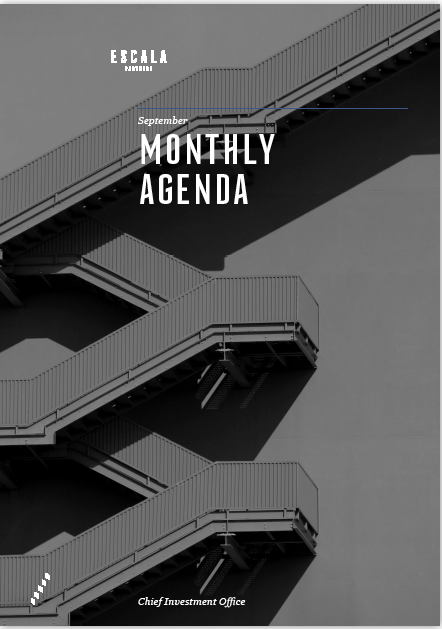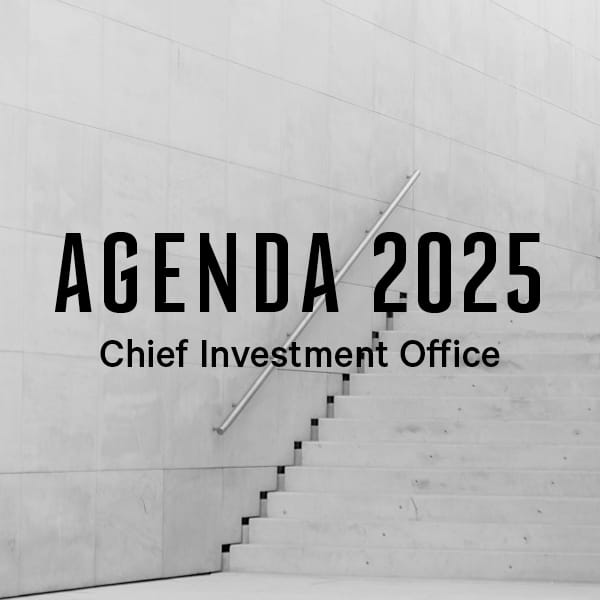-
Overview

The global economy has transitioned into mid-cycle over recent quarters, rebounding sharply from the events triggered by the COVID crisis. Historically, mid-cycle investing can be challenging for asset allocators in part due to the much greater dispersion in sector and individual positioning in such an environment. Greater active management is thus preferred in this phase of the cycle. This month we assess how our Alternatives model portfolio is placed in these rapidly changing conditions.
-
Partnering with experienced managers

In mid-2020, we placed a directional trade in the alternatives sector. To date the trade has yielded a profit of 14% which is above the initial targeted profit level. The profit and loss review level has subsequently been revised upwards to lock in the gains. The trade is likely to be extended given our high conviction level in the alternatives sector relative to the cash rate. We’re not expecting to implement too many more tactical trades in the near-term. This is a time in the cycle to focus on manager selection.
Chart 1: Alternatives CIO model of managed funds

Source: Escala Partners
Mid-cycle is an important time to be selecting managers who are active so that risk can be refined. Given this focus on manager selection, mid-cycle is the ideal time to take a deeper dive into the underlying investments of your portfolio and ensure things are being managed as expected. The health check looks through the funds that we are invested in at an individual position level and then it aggregates back up across geography, sector, and style. The intention is to identify where the risk in the model is coming from and to discuss whether we are happy taking that risk; that we are being rewarded for taking that risk; and if we need to take corrective action to offset the risks that we don’t want to take.
The alternatives sector as a collective is diverse and include such vehicles as hedge funds, private equity, venture capital, private debt and real assets such as real estate, infrastructure and natural resources. The sector has not been immune to a range of unpredictable global and macroeconomic events. Central to this were the impacts of the COVID crisis and the resulting market volatility in the prior year. There have been some large performance dispersions across different alternative strategies, which helps to highlight the heterogeneity of the asset class.
Post-COVID, the strength and speed of the rebound suggest resilience and continued momentum as investors increasingly look to private markets for higher potential returns in a sustained low yield environment. The combination of low interest rates, diversification and lower correlation with public markets provides an attractive investment landscape.
More recently, we have increased the allocation to alternatives. This reflects our view that this asset class offers greater risk-adjusted return potential providing investors can accommodate the illiquidity risk that this comes with.
One key takeaway from our model is that the portfolio has a relatively balanced exposure across multiple alternative strategies providing exposure across a diversified range of assets and geographies. At a top down level, our model has a reasonably high exposure to the more cyclical sectors of the market (41.8%) compared with economic sensitive (31.4%) and defensives (26.8%). While these sectors stand to perform well early cycle (and this has certainly been the case over the last several months), the conditions become less favourable as the cycle matures.
Chart 2: Alternatives Model Portfolio Sector Exposure

Source: Escala Partners
-
Private Equity

Private equity allocations have increased globally as more investors seek to add additional layers of diversification to a portfolio of traditional listed equities and fixed income at this time. The lower correlation with listed equities adds increased diversification needed during periods of market volatility which can be common as we move through the phases of recovery at a rapid pace whilst the lower for longer environment has increased the relative attractiveness of the illiquidity premium offered by private markets.
Private equity is not without its challenges however, with record amounts of dry powder sitting on the side-lines looking for attractive takeover targets and public market valuations at extremes, the starting point for many private equity managers now is tougher than ever before. With this in mind, we continue to favour experienced managers who have navigated private equity portfolios through many past cycles with the ability to apply different investment styles and a considered portfolio allocation approach at this point.
-
High valuations – a double edged sword
High valuations in the public markets have provided private equity managers with attractive opportunities to sell mature portfolio companies and lock in gains. This is highlighted by Pitchbook data which showed 2021 is on track to be a record year with over $350 billion in deals through the first half of the year alone. The challenge comes with where to redeploy capital. Identifying leaders in fragmented markets at the early stages of industry consolidation has become an active focus for our PE managers to counteract expensive valuations.
A look at a blended allocation of our preferred private equity managers, Partners Group Global Value Fund and Hamilton Lane Global Private Assets Fund, shows both have actively tilted their portfolios toward the more defensive sectors of healthcare, technology and parts of the industrials complex whilst both are underweight financials compared with listed markets. This focus on allocating to sectors with secular tailwinds is important as we move into a period of slower economic growth associated with mid-cycle phase.
Chart 3: Private equity sector exposure

Source: Escala Partners
-
Healthcare in focus
Healthcare is an area where our private equity managers both have a bullish view; aside from the pandemic related spending needs, longer term secular trends such as aging populations and increased trend in digitisation of many parts of outdated healthcare systems mean it remains a resilient sector for investment throughout the cycle. Partners Group have targeted EyeCare Partners, a leader in the highly fragmented medical vision market, a non-cyclical US $52 billion industry supported by long-term tailwinds. Hamilton Lane counts Sogo Medical within its top 10 holdings, a leader in the Japanese pharma industry with over 700 pharmacies and vertically integrated supply chain operations across Japan.
Regionally our PE portfolio has a greater allocation to Europe versus listed markets. This is a function of the deal flow our managers see, with Partners Group a leader in European private markets they have deployed greater amounts of capital in the region. Interestingly, a quick look at the performance of European private equity (Standard Life European Private Equity Trust) compared with its listed counterpart (Stoxx Europe 600 Index) shows private markets have outperformed substantially, 18.9% p.a. vs 9.9% p.a. on a five-year basis. Compositionally European private markets are generally weighted toward information technology, healthcare and industrials whereas listed markets have a much larger weight to banks and insurers which have suffered from negative interest rates in the region for some time.
Chart 4: Private equity regional split

Source: Escala Partners
-
Private Debt

Private debt markets have grown exponentially over recent years fuelled by long-term secular trends – in particular, the disintermediation of bank lending channels due to regulatory developments in the wake of the GFC, as well as sustained low interest rates on traditional fixed-income securities due to accommodating monetary policy. In 2020, fundraising was also propelled by appetite for credit strategies targeting the COVID-driven market dislocation.
Private debt fundraising has kept a steady course in 2021. Low interest rates, subdued default rates, surging liquid credit markets and the longer-term pivot toward alternative strategies continue driving investors into private debt strategies. Heavily dependent on other private capital strategies and M&A for deal flow, private lenders and debt investors have seen a range of deployment opportunities in the last year. Within private debt markets, direct lending continues to stand out, accounting for about half of all capital raised.
-
$10 billion agriculture funding gap
Within the model portfolio’s private debt exposure, there exists a diversified range of sector exposure across Australia and New Zealand. The Merricks Partners Fund provides diversified exposure (circa 40-50 loans) predominantly across the agriculture (30%) and commercial real estate (60%) sectors. The agricultural sector is a favoured given the current funding gap estimated to be in excess of $10 billion across Australia and New Zealand with limited competition. The investment in the sector provides diversified exposure across multiple sub-sectors including dairy, poultry, horticulture, cropping and livestock. Examples of existing agriculture positions include Cherri Global, which owns four cherry orchards in the Central Otago region of New Zealand. Another core position is Maughan Farming Group which operates a large-scale dryland and irrigated broadacre cropping and dairy enterprise across 8,000 hectares in northern NSW.
More recently, the agricultural sector has benefitted from a range of tailwinds with agricultural commodity prices remaining strong and weather across the East Coast and WA highly favourable. Agricultural land prices are at record highs and institutional funds continue to make large investments across the sector. As a result, a strong pipeline of opportunities exits and a strong medium-term outlook for the sector.
The largest allocation in the Merricks Partners Fund is to the commercial real estate sector which again is highly diversified across multiple sub-sectors such as office, hotel, retail, land subdivision and apartments. Within this, the largest exposure is to the office sector (24%) albeit the exposure has been reduced over the recent quarter. There has been a lot of conjecture about future office demand due to lockdown measures, combined with a shift in supply dynamics due to tighter lending criteria and pre-commitment hurdles. Despite current lockdowns in Melbourne and Sydney, there continues to be strong demand from local buyers for prime office buildings. This is being driven by the low cost of capital and liquidity as well as limited supply of prime office product in good locations. Several of the largest positions include: 424 St Kilda Road, Melbourne which is a commercial office building which is a triple-fronted corner site featuring two office towers 0.5km from ANZAC Station. The loan is senior secured registered first mortgage with a term of 24 months.
A recent addition to the model portfolio has been the inclusion of the Realm Strategic Income Fund. The strategy takes an opportunistic approach in allocating capital to sectors and programs. The goal is to take advantage of idiosyncratic factors, such as regulation or any other supply/demand factors that provide an additional return. While not specifically targeted, the Fund is expected to exhibit the following sub-asset class exposures at full investment: RMBS Warehouse Facilities – 50%; ABS Warehouse Facilities – 25%; and Corporate Secured Loan Facilities – 25% whilst being mindful with diversification, maturity profile and credit quality considerations. This addition provides further diversification to the model portfolio’s private debt allocation. Across the private debt model portfolio, most of the duration is to the liquid end of the market.
Chart 5: Private debt model blended duration

-
Hedged Funds
The environment for hedge funds has become increasingly more optimistic, benefited from ongoing government fiscal interventions and central bank support that sustained the equity market rally and underpinned equity hedge returns. Coupled with this, high merger and acquisitions (M&A) activity, including defensive M&A in pandemic-hit sectors has provided a raft of opportunities.
The hedge fund allocation in the model portfolio is well represented by two of the key sectors of the market that are expected to perform well as we move into mid-cycle, being information technology and communication services.
Chart 6: Sector Exposure

Source: Escala Partners
-
Tech disruption impactving multiple sectors
investment allocation provides a range of exposures with the focus on finding long term structural winners. One of the largest themes that we are happy to continue to see reflected in our model hedge fund allocation is tech disruption. One of the observations we make regularly is the extent to which companies across many different sectors are benefitting from new technology.
Table 1: Investment Themes

Source: Munro Partners
At a geographic level, the hedge fund model allocation is primarily exposed to equities in the United States and Europe with some minimal exposure outside of these regions. Munro removed its exposure to China several months earlier (e.g. positions in Alibaba, Tencent) given the heightened uncertainty in the region.
The level of exposure employed has remained broadly consistent across the past few years with gross exposure managed between 100-110% and net exposure circa 90%. Munro maintains a highly liquid portfolio which provides the ability to tactically move the portfolio’s exposure during times of market stress. For example, at the height of the COVID-19 crisis Munro reduced the Fund’s net exposure to circa 25% via trimming long positions and increasing the level of shorts. The Fund also maintains a large US dollar exposure having increased this from 50% to 60% over recent times using this exposure as a form of downside protection. For Australia investors, being unhedged (overweight mainly USD) helps to build in some protection. In the event of a sell-off in international equities, the US dollar tends to rise. This will cushion the impact of the selloff for Australian investors when returns are translated back into Australian dollars.
Table 2: Top 5 positions

Source: Munro Partners
-
Direct Property

In the direct property asset class, we have an allocation to office property with the Charter Hall Direct Office Fund (DOF). Charter Hall’s philosophy has served the DOF well during what is likely to be its toughest test as their focus on A grade office buildings in prime CBD locations in the major cities across Australia has provided the fund with the defensive portfolio characteristics necessary at a time when the office property market more broadly is coming under pressure. Key to the approach with this fund is the focus on high quality tenants, over 60% of the fund’s tenant profile is made up of government entities, state backed universities and ASX 200 listed large cap companies.
Chart 7: Charter Hall DOF Tenant Profile

Source: Charter Hall
As transaction activity begins to pick up the result of the pandemic will mean a bifurcated outcome for valuations in the office property market, A-grade buildings with long lease profiles have seen capitalisation rates compress and valuations increase whilst B-grade and lower lease buildings are seeing valuations fall. More broadly the yield on the DOF remains resilient for income focused investors as the spread on real assets such as direct property above long term interest rates remains close to record levels.
Stephen Dickinson
Investment AnalystDarragh Kennelly
Investment Analyst


















